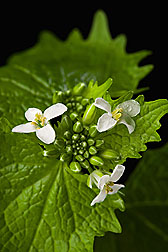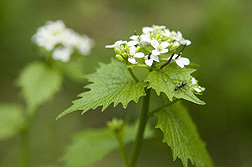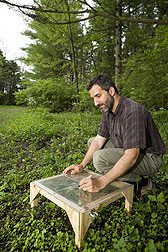Munching on Garlic Mustard
A New Weevil in the Works
|
|
Garlic and mustard are common ingredients that can be found in American households. But garlic mustard? Well, that’s a different story.
Garlic mustard, Alliaria petiolata, is considered one of the most problematic invaders of temperate forests in North America. According to legend, it was brought here from Europe in the 1860s as a culinary herb, but unfortunately, it doesn’t taste very good. Since then, garlic mustard has spread to 34 U.S. states and 4 Canadian provinces.
“Garlic mustard is an invasive plant that gets a lot of attention,” says ecologist Adam Davis, who has been studying the weed for years. “It’s very noticeable and hard to eradicate because of its seed bank.”
The term “seed bank” refers to seeds in the soil that are dormant but capable of germinating. Garlic mustard seeds can remain viable for more than 10 years. A single plant can produce hundreds of seeds, which scatter as far as several meters from the parent.
“You can spend a lot of time and money pulling garlic mustard up or spraying it with pesticides, but it’ll just come back the next year,” says Davis. “That’s why it’s such a problem. It’s very resilient.”
|
|
A member of the mustard family Brassicaceae, garlic mustard got its name because its leaves, when crushed, smell like garlic. Garlic mustard is a biennial plant, meaning it takes 2 years to complete its life cycle. During its first year, the plant is in the form of a rosette with kidney-shaped leaves that remain green throughout the winter. In its second year, the plant matures and produces small, white flowers, each with four petals in the shape of a cross. The mature plants either self-pollinate or are pollinated by insects, producing seeds that fall to the ground and enter the soil.
Garlic mustard is cold hardy and shade tolerant, enabling it to grow early in spring when most plants are not able to grow. It also secretes allelochemicals into the soil. Allelochemicals are chemical compounds a plant introduces into the growing environment to suppress growth of another plant. “It’s kind of like chemical warfare against the native plants,” says Davis.
The insects and fungi that feed on garlic mustard in its native habitat are not present in North America, increasing the weed’s seed productivity and allowing it to outcompete native plants.
A Model Solution
To better understand garlic mustard and find a suitable biocontrol, Davis—in collaboration with colleagues at Michigan State University, Cornell University, the University of Illinois, and the Centre for Agricultural Biosciences International (CABI) in Switzerland—created a computer model that simulates the weed’s life cycle.
“In part, we wanted to answer ecologists’ criticisms that biocontrol can potentially cause as many problems as it solves because of unintended consequences,” says Davis. “We were looking for a way to choose agents that are most likely to succeed while reducing their potential for harm to native plants and environments. Ideally, we want to try to release only one organism, if possible.”
Through this model, Davis was able to predict the type and severity of damage that would be needed to reduce garlic mustard’s population growth rates. Davis performed an analysis using computer code that enabled him to change one variable at a time while keeping all the others constant, allowing him to probe the life cycle for the plant’s weak point. He found that in order to make an impact, a biocontrol agent has to reduce garlic mustard’s survival in the rosette stage and its ability to reproduce in the adult stage.
Well before Davis created the life-cycle model, CABI scientists began looking for and testing potential biocontrol agents to tackle garlic mustard. They collected data on the amount of damage each insect could inflict on the garlic mustard population. From a list of more than 70 natural enemies found to be feeding on garlic mustard in Europe, four Ceutorhynchus weevils were selected as the most promising control agents.
Combining the feeding information collected by CABI scientists and the demographic information of garlic mustard in North America, Davis used the computerized life-cycle model to assess each weevil’s ability to inflict damage on the weed and inhibit its growth. One weevil, C. scrobicollis, came out on top.
High Hopes for Little Insect
The tiny C. scrobicollis has a life cycle of 1 year and produces one batch of offspring per lifetime. Itlays its eggs on garlic mustard’s leaf stems in the fall. When the eggs hatch in the spring, the larvae feed on the weed’s root crown, the area from which the rosette’s leaves grow and where nutrients are stored.
By feeding on the root crown, C. scrobicollis stops the flow of nutrients and water from the roots to the rest of the plant. It also damages the meristem, the area of the plant where new growth takes place. As a result, garlic mustard produces fewer seeds or, in areas with high weevil populations, dies prematurely in early spring without producing any seeds.
C. scrobicollis also appears to be monophagous, meaning it eats just one thing: garlic mustard. That means scientists won’t have to worry about any unintended consequences when using this insect as a biocontrol agent.
During preliminary testing, CABI scientists believed C. scrobicollis was the best candidate to control garlic mustard. Putting the weevil’s feeding data through Davis’s life-cycle model confirmed their beliefs and created a stronger case for the permit process.
“The model gave teeth to the permit application to release this weevil in the United States,” says Davis. “It provided a peek into the future as to the impact the weevil could have on the garlic mustard population here.”
C. scrobicollis is currently in quarantine at the University of Minnesota. If all goes well, this beneficial weevil may soon be roaming North America to find a nice garlic mustard meal.—By Stephanie Yao, Agricultural Research Service Information Staff.
This research is part of Crop Protection and Quarantine, an ARS national program (#304) described on the World Wide Web at www.nps.ars.usda.gov.
Adam Davis is in the USDA-ARS Invasive Weed Management Research Unit, 1102 S. Goodwin Ave., Urbana, IL 61801-4730; phone (217) 333-9654, fax (217) 333-5251.
"Munching on Garlic Mustard: A New Weevil in the Works" was published in the July 2009 issue of Agricultural Research magazine.









